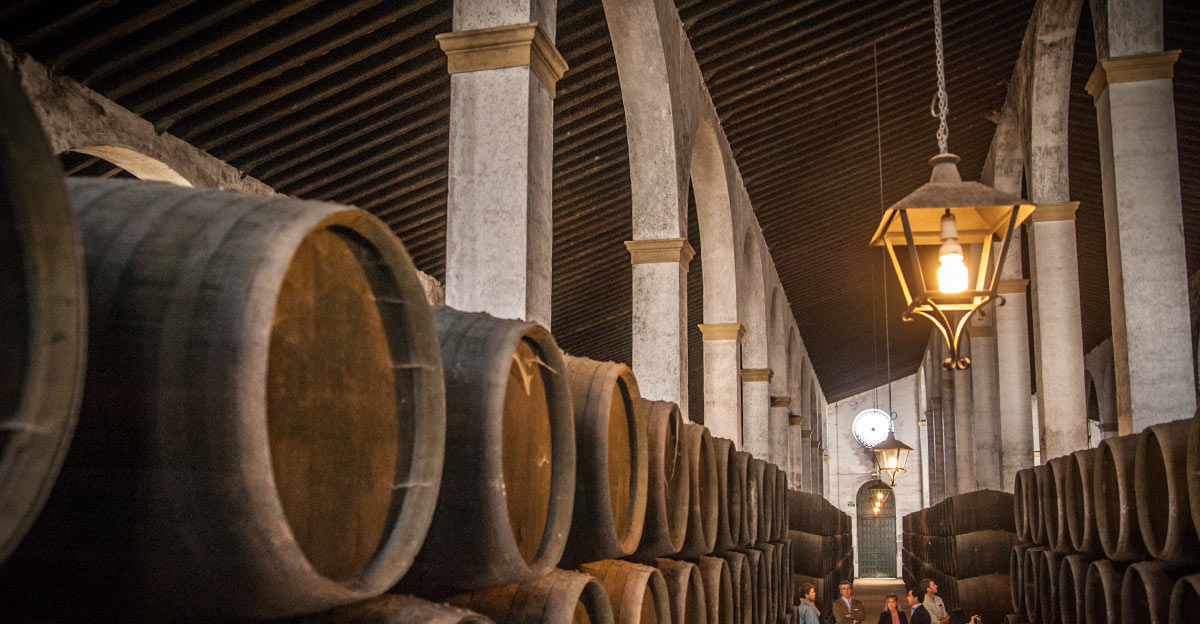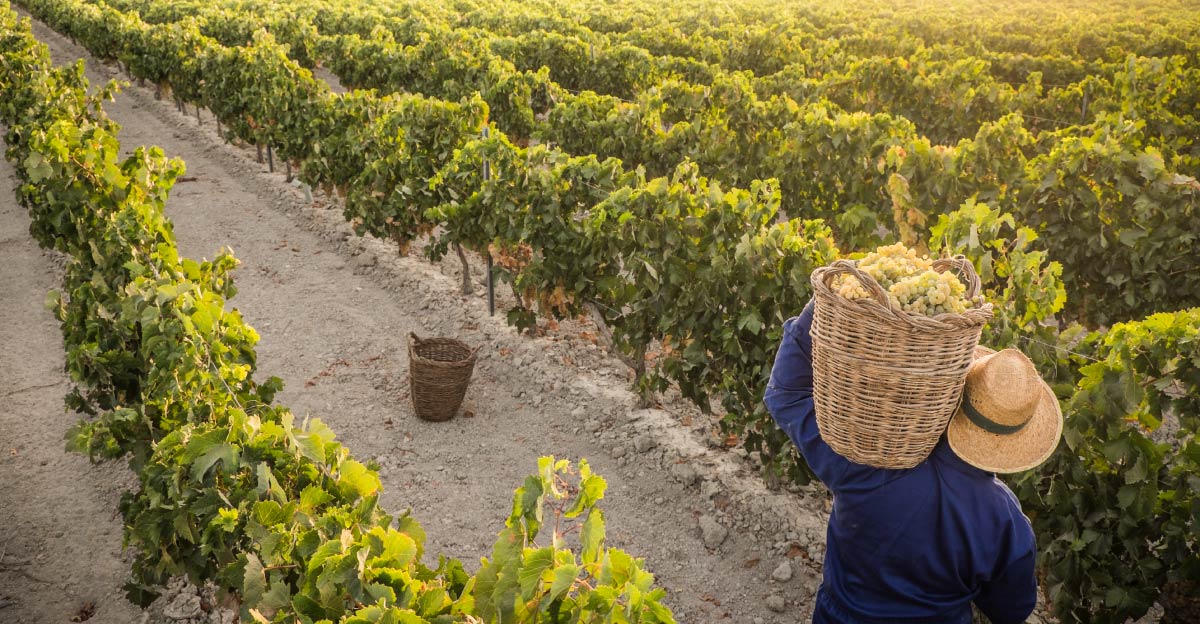The wines produced in the area are very diverse, different, and sometimes even opposite in characteristics, personality, or profiles. Each of Spain’s and Jerez historical periods have helped shape not only the local culture and language, they have also influenced these wines and the way of enjoying them. As a result they have been identified, named in different ways, either by the locals or foreigners visiting the region arriving from all parts of the world.
Sherry plainly means Jerez. In other words, this diverse group of wines is known and labeled the same as the most important city in the region (Jerez de la Frontera). When you see the word “Sherry” on the labels, you’re simply reading “Jerez”. Additionally, “sherry” refers not only to the dry wines of the area but also to the sweet, blends, biologic, and oxidative ones*.
*Popularly (although incorrectly) they are all known as sherry even though Manzanilla de Sanlúcar, despite being crafted in the same way as the finos, belongs to a different designation of origin and nomenclature”

The words jerez, jereces, sherry, sherries… all mean the same thing. These terms refer to a unique category in the world that is full of nuances, flavors, and personalities. The terminology, like the region, is also very ancient and is the result of centuries of evolution, linguistic adaptations, accents, and political, religious, and diplomatic conflicts.
THE HISTORICAL ROOTS OF THE TERM “SHERRY”

The word “jerez,” has undergone adaptations and evolutions according to the civilizations, languages, and cultures of the people who populated and frequented the area over millennia. Thanks to historical documentation, the origins of the city and region unfolded, the toponymy of every corner of the Jerez – Xérès – Sherry DO. Discover below those responsible and how it came to be known as “Jerez.”
*Go to the end of the chapter to learn where the word “Xérès” comes from and why it appears in the DO official naming.
• Xera: That is the name given by the Phoenicians to a settlement located near the current city of Jerez de la Frontera location. According to the Greek historian Strabo, this settlement was founded around 1100 BC (3,324 years ago).

• Ceret: Also spelled “Seret.” Following internal wars among Greeks, Carthaginians, indigenous tribes, and the eventual arrival of the Roman Empire to the Iberian Peninsula, the Phoenician settlement known as Xera became Latinized and referred to as “Ceret.” The peninsula became part of the Roman empire as province, unifying colonies, settlements, and cities that had been founded by former civilizations established in the territory. At this time there was a homogenizing of the different names into Latin, the official language of the Roman Empire. It is from this historical period that the wine produced in the region began to be known as “wine from Jerez,” or in this case “vinum ceretensis.”
• Xeritium: Or “Seritium.” Although the origin of this word is not entirely clear (it may be a late Latinization of the word “Xerez”), this name is assigned to the city (or cities) near the current location of Jerez de la Frontera during the reign of the Visigoths.

The Visigoths were people from Northern Europe who initially collaborated with the Roman Empire but eventually settled in the Iberian Peninsula and took control of the area after the fall of the Roman Empire (476 AD).
• Šeriš: The first name associated with Jerez during the Muslim era (Šeriš). It comes from the name of a village of an industrial character where wines were produced in amphora or “serias,” pronounced as “serés.” With the arrival of the Muslims from North Africa, Jerez began to grow, expand, and take shape as a medieval city, and its name would evolve into the Arabic form شريش or “Sherish.” This word begins to hint at where the word “sherry” evolved from.
• Xerez: The return of the Christian kingdoms (keeping a low profile in the north of the peninsula during the hegemonic presence of the Muslim kingdom of Al-Andalus) caused a new cultural, linguistic, and religious change in the Iberian territories, giving rise to a period where Spanish, still very similar to Latin, began to mix with Al Andalus words and expressions. The name of the city became known as “Xerez,” retaking the original phonetics of Šeriš (“serés”).
◦ The use of the “x” instead of the “j” in the word is due to a simple reason. In Latin or the early versions of medieval Spanish, the current phoneme associated with “j” did not exist, so the name of the city ended up being represented by the phoneme /ʃ/ (similar to the English “sh”) associated with the grapheme or letter “X.”
• Xerez (de la Frontera): The continuous political and diplomatic conflicts occurring during this period caused the city of Jerez to become known as “Xerez de la Frontera” simply because it was located exactly on the border between the Kingdom of Castile, Christian territory, and the Kingdom of Granada, the last Muslim kingdom in Spain.
“De la Frontera” means “from the border”. Currently, there are many towns and cities in southern Spain with “de la Frontera” attached to their place names. Examples close to Jerez include Arcos de la Frontera, Castellar de la Frontera, Chiclana de la Frontera, Conil de la Frontera, Jimena de la Frontera, or Vejer de la Frontera.
• Jerez (de la Frontera): In the 16th century, when the Christian kingdoms of the peninsula were unified and organized, the phoneme /ʃ/ evolved to /X/, exactly the sound of “j.” In the 18th century, the spelling reform by the Real Academia de la Lengua (the Royal Spanish Language Academy) replaced the “X” letter with the grapheme “J,” making the name of the city and the region go from Xerez into Jerez.
EVOLUTION OF THE WORD “SHERRY” OVER TIME
Xerez was the name given to the city in several languages until a few centuries ago; however, this medieval term still influences the names given to the wine produced in the region in many different countries: in Portuguese and Galician, xerez [ʃəˈɾɛʃ]; in Catalan, xerès [ʃəˈɾɛs]; in French, xérès [gzeʀɛs]; or in Italian, xeres [ˈksɛɾes].
The long and active interaction of the city and the region with the British also led to the internationalization (and subsequent adaptation) of the word “Jerez” into English. This however, the phonetic differences between Spanish and English are more notable, prompted a more radical adaptation of the city and wine’s name by the British, using the toponym “Sherish” and updating it to “Sherry.”
SACK, SHERRY, AND THE SHERRY CASE
Before the word “sherry” was established to identify these wines by the English and British, it was known as “sack.” The word “sack,” a translation of the word “saca,” (withdrawal) referred to wines from various areas in the 16th century. To determine and differentiate them, the regions of origin of each wine were added to the word “sack” (sherry sack, etc.). Diplomatic, political, and commercial circumstances between Spain and England made sherry a highly prized product by the English, though this is part of another long and exciting story. Returning to “sack,” several renowned authors, such as William Shakespeare, referred to “sack” or “sherish sack” in some of their works, an already popular wine that was competing with another Spanish wine of the time, Canary sack.

Benjamin Jonson, Contemporary of Shakespeare, probably left one of the few documents that helped to know that Jerez wine changed from “sack” to “sherry” at that time. The phrase he left in his legacy was: “Sack? You said but e’en now it should be sherry.”
The adoption of the word “sherry” as a generic category of wines (fortified, dry, and sweet each with its own personality and expression) prompted many non-genuine wine producers outside of the sherry region to label their wines as “sherry,” thus starting the biggest and most famous conflict between sherry wineries and other world wine producers: “the Sherry Case.”
“Sherry Case”, a trial that legally pitted the wineries of the Sherry DO against the producers of the then-known “British Sherry.” In June 1965, a group of British importers of wines from the region, members to the “Sherry Shippers Association”, filed a lawsuit in defense of genuine and authentic sherry, while manufacturers of “British sherry” requested the British court to allow the use of the term “sherry” for wines made in the Commonwealth.
July 30, Judge Sir Arthur Geoffrey Cross delivered the verdict to the parties. The definitive ruling was radical: the British thesis that the term “sherry” was generic was rejected, siding with the representatives of the Sherry DO. A remarkable success, laying the first step to guarantee the exclusivity of the use of the word “sherry” only for producers in the region preventing other countries from illegitimately using the term “sherry.”
A decisive piece of evidence that helped win the trial was a medieval map from the Al-Andalus period that included and well represented the city of Sherish. This simple detail was the ultimate clue to demonstrate that the term “sherry” was an exclusive and historical word for the city and that the wines produced in the region were not a generic category. This map was drawn in 1100 by the geographer Al-Idrisi.

SHERRY AS A PROTECTED DESIGNATION OF ORIGIN (D.O)
The first wine law in Spain was published in 1933, including among others the Marco de Jerez as a historic Spanish wine region. In 1935, the Regulatory Council of the DO was established, setting the official naming of the region as Jerez – Xérèz- Sherry, as a tribute to the three languages that represented the past and present of the region: Jerez, in Spanish, for its origin; Sherry, in English, for the long-standing commercial tradition these wines have in the United Kingdom and other English-speaking countries; Xérès, in French, due to the influence of several French communities in the region.
The official name of the DO, therefore, if translated into a single language, is Jerez – Jerez – Jerez. Quite easy to remember.







